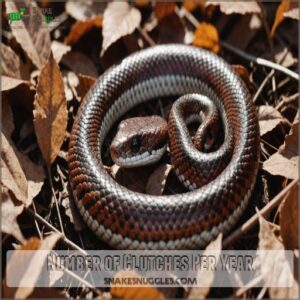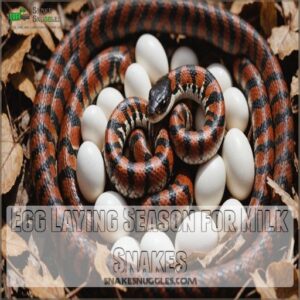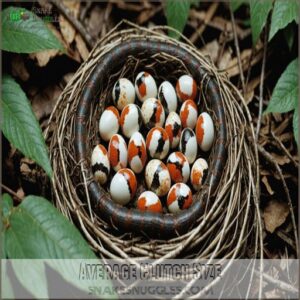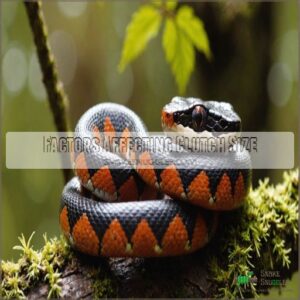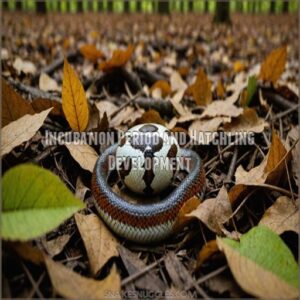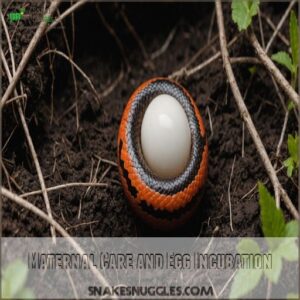This site is supported by our readers. We may earn a commission, at no cost to you, if you purchase through links.
 Milk snakes usually lay eggs once a year, but occasionally they might surprise you with a second clutch.
Milk snakes usually lay eggs once a year, but occasionally they might surprise you with a second clutch.
These charming ophidians plan their reproductive cycles around warmth and food abundance.
So, if you’re in the right snake-appropriate climate, you might see those eggs around late spring or early summer.
While they’re not exactly throwing egg parties, their yearly rhythm is quite consistent.
Think of it as a scaly calendar event, minus the birthday cake.
Curious about those eggs’ journey from clutch to hatchling? Stick around to uncover how these fascinating creatures welcome new life into the world.
Table Of Contents
- Key Takeaways
- Milk Snake Reproductive Biology
- Reproductive Cycle of Milk Snakes
- Frequency of Egg Laying
- Egg Laying Season for Milk Snakes
- Number of Clutches and Eggs Per Clutch
- Incubation Period and Hatchling Development
- Maternal Care and Egg Incubation
- Factors Influencing Milk Snake Reproduction
- Frequently Asked Questions (FAQs)
- When do snakes lay eggs?
- How long are snake eggs?
- What snakes do not lay eggs?
- Do snakes lay eggs like birds?
- How often do snakes breed?
- Can a snake hatch an egg?
- How often do milk snakes breed?
- Where do milk snakes go in the winter?
- How many milk snakes are in a litter?
- What is the life cycle of a milk snake?
- How long do milk snakes live?
- What do baby milk snakes eat?
- Are milk snakes aggressive towards humans?
- How do milk snakes hunt their prey?
- What habitats do milk snakes prefer?
- Conclusion
Key Takeaways
- You’ll typically find milk snakes laying eggs once a year, although they might surprise you with a second clutch occasionally.
- Their egg-laying schedule is heavily influenced by the availability of warmth and food in their environment.
- Females often lay their eggs in late spring or early summer, timing it with favorable conditions for egg development.
- The number of clutches and eggs can vary based on factors like climate, diet, and the female’s health, affecting their reproductive success.
Milk Snake Reproductive Biology
Milk snakes, popular for their vibrant patterns, reproduce primarily by laying eggs, an efficient strategy shared by about 70% of snake species.
Milk snakes produce eggs annually, leading to delightful surprises for snake enthusiasts.
As you explore their reproductive biology, you’ll discover that their fascinating approach to reproduction involves producing eggs annually, leading to delightful surprises for snake enthusiasts.
Reproduction Method
Peeking into milk snake reproduction, you’ll discover a fascinating tale of mating strategy.
First, sexual dimorphism influences courtship rituals. Males, drawn by pheromones, engage in intricate mating behavior.
Second, fertilization occurs internally.
Third, parental care is minimal, reflecting typical snake behavior.
Finally, their flexible strategy adapts well to diverse environments.
Intriguing, isn’t it?
Egg-Laying Vs. Live Birth
Milk snakes, masters of egg-laying, follow an evolutionary history distinct from their viviparous and ovoviviparous relatives.
Unlike some snakes with elaborate maternal care, milk snakes adapt environmentally to guarantee reproductive success, often laying eggs in ideal temperature-dependent nesting sites.
They don’t bear live young, favoring clutches of eggs tucked safely away, adapting their strategies to habitats for maximum survival, like a savvy survivalist packing only essentials.
Frequency of Reproduction
Imagine the rhythmic clockwork of milk snake reproduction, ticking with seasonal precision.
These snakes typically have one breeding season each year.
Their mating frequency and clutch sizes can vary, influenced by environmental factors.
You can find a range of products for milk snake reproduction on this website, including incubation supplies and care guides.
While some species boast prolific egg-layers, their growth patterns reveal that milk snakes typically reach full maturity around two years of age, with factors influencing size, milk snakes strategically balance their reproduction rates with clutch size variation, ensuring robust offspring thrive with nature’s seasonal variations.
Reproductive Cycle of Milk Snakes
Understanding a milk snake’s reproductive habits, which vary by species such as the Honduran Milk Snake species, is key to successful breeding.
Following mating, which often involves elaborate rituals, the female’s body undergoes significant changes.
Egg development is a fascinating process, involving yolk formation and shell development.
This period is essential for the survival of future hatchlings; proper nutrition and environmental conditions are paramount.
The gestation period varies depending on species and environmental factors.
Typically, milk snakes mate in the spring or early summer, with mating season and courtship.
During this time, the female’s body prioritizes the developing eggs, demanding extra energy.
Once the eggs are fully developed, the female will seek a suitable nesting site, exhibiting specific nesting habits.
She carefully prepares the location before laying her clutch of eggs.
The number of eggs varies, influenced by the mother’s size and health.
Incubation begins, a critical phase where temperature and humidity play a significant role in egg development and hatchling success.
Milk snake egg development is a delicate balance of internal and external factors.
Successfully understanding this cycle requires a thorough understanding of milk snake biology.
Frequency of Egg Laying
You’re about to uncover how often milk snakes lay eggs, a process influenced by several factors.
From the number of clutches per year to the time between them, understanding these rhythms might help you appreciate why milk snakes don’t carry calendars.
Number of Clutches Per Year
Milk snakes typically produce one to two clutches per year.
Factors like environmental impacts, such as temperature and food availability, greatly influence this clutch frequency.
For instance, a better habitat like those with ideal incubation temperatures can lead to larger clutches and healthier eggs.
Individual differences and age can lead to clutch size variation.
Some might surprise you with more than two, but generally, it’s a predictable, rhythmic dance with nature.
Time Between Clutches
Female milk snakes are relatively easy to breed, laying eggs in warm, humid environments after successful milk snake breeding. You might wonder how much time milk snakes need between clutches. Typically, they pause about four to seven weeks.
During this interlude, they focus on:
- Recovery: Regaining energy after eggs are laid.
- Egg Development: Forming the next clutch internally.
- Nutrient Accumulation: Sufficient diet intake.
- Environmental Conditions: Waiting for favorable weather.
- Instinctive Timing: Nature’s own scheduling.
Curiously, it’s all about clutch timing and spacing!
Factors Affecting Egg Laying Frequency
Egg-laying frequency in milk snakes is a dance with nature.
Age, climate, diet, stress, and population density all play roles in this complex equation.
| Factor | Impact on Frequency | Example |
|---|---|---|
| Age | Older snakes lay fewer | Juvenile advantage |
| Climate | Warm boosts frequency | Cold reduces activity |
| Diet | Rich diet increases | Sparse diet decreases |
Understanding these factors helps to promote healthier snakes and more eggs.
Egg Laying Season for Milk Snakes
You’d be surprised how milk snakes choose the ideal time to lay their eggs, relying on environmental cues like temperature, humidity, and daylight length.
Understanding these triggers helps you appreciate how nature perfectly synchronizes the snakes’ reproductive cycle with their surroundings.
Environmental Triggers
Milk snakes decide to lay eggs when they pick up on specific environmental triggers.
You might find them responding to:
- Changes in daylight hours signaling spring
- Food availability boosting energy reserves
- Mild climate changes increasing survival odds
- Cues from the habitat like nesting spots
- Seasonal shifts encouraging reproduction
Interestingly, these natural signals act like a green light for their reproduction cycle!
Temperature and Humidity
Environmental cues, like rainfall, signal the start of a milk snake’s breeding season.
But, ideal temperature and humidity levels are key to successful egg development.
Get it wrong, and you might see problems.
| Temperature (°F) | Humidity (%) | Impact on Egg Development |
|---|---|---|
| 75-85 | 60-70 | Ideal for incubation |
| 70 | Overheating; increased risk of embryo mortality |
Proper humidity control within your snake’s enclosure is essential.
Photoperiod and Egg Laying
Just like you prefer longer days in summer, milk snakes find longer daylight hours—called the photoperiod—too tempting not to think about for reproduction.
These light changes trigger:
- Breeding Season Onset: Longer light cycles cue snakes to start breeding.
- Egg Laying Cues: Influenced by light duration, snakes plan clutches.
- Timing Adjustments: Photoperiod impacts how snakes schedule their reproductive efforts.
Number of Clutches and Eggs Per Clutch
When you’re curious about milk snake reproduction, you’ll find they usually lay one to three clutches of eggs each year, with the number of eggs per clutch varying widely depending on environmental conditions and the female’s health.
Typically, each clutch contains between six and twenty-four eggs, showcasing nature’s unpredictability and the snake’s adaptability to its habitat.
Average Clutch Size
Understanding a milk snake’s clutch size is like discovering nature’s secrets.
On average, these resilient creatures lay between 6 to 15 eggs annually.
Their clutch size isn’t just a number; it’s influenced by dietary impact and stress factors.
Geographic differences also play a role, where clutch size trends show fascinating variations, making each clutch uniquely adapted to its environment.
Range of Clutch Sizes
Milk snakes’ clutch sizes show an intriguing range, typically consisting of 6 to 11 eggs per clutch.
However, life’s full of surprises, and nature’s no exception, so exceptions are possible.
- Average clutch size: 6-11 eggs
- Clutch size variation: Larger females may lay more eggs
- Clutch size by region: Influenced by climate and habitat conditions
Understanding these patterns helps you appreciate their unique reproductive strategies.
Factors Affecting Clutch Size
Milk snakes can grow rapidly, potentially doubling in size during their first year, as discussed in terms of growth rate slows. Age, stress, and climate have a big impact on a milk snake’s clutch size.
Older snakes might lay smaller clutches, while stress can reduce egg production.
Adequate food availability is key, as nutrition directly affects reproduction.
Genetics also play a role, shaping potential clutch numbers.
Like a chef needing the right ingredients, milk snakes require the best conditions for laying a feast of eggs.
Incubation Period and Hatchling Development
You’ll find that milk snake eggs take about 50 to 70 days to hatch, during which the developing embryos rely heavily on temperature and humidity levels.
Once they hatch, the tiny snakes start their independent journey, often reminding us how quickly nature teaches them the ropes of survival with minimal parental guidance.
Length of Incubation Period
Discover how long you’ll wait for those adorable milk snake hatchlings! Incubation periods depend on several factors.
- Temperature variations greatly impact development speed; warmer temperatures generally lead to faster hatching.
- Nest site impact also matters; well-insulated nests offer more stable temperatures.
- Factors influencing incubation, like humidity, also play a role.
Expect a range of 50-70 days, but patience is key.
Hatchling Characteristics
Hatchling milk snakes emerge vibrant with distinct color patterns, often mesmerizing in their tiny size.
Their brilliant bands aren’t just for show; they play a key role in survival by warding off predators.
Similar to corn snakes, which typically take successful incubation temperatures, milk snakes require precise conditions to thrive after hatching.
Despite their delicate beginnings, hatchlings grow rapidly, tapping into natural curiosity and a voracious appetite, enhancing their growth rate and boosting their survival chances in the wild.
Post-Hatching Development
As these milk snake hatchlings emerge, they’re not quite ready for the world’s grand stage.
Hatchling growth takes focus; they’re tiny explorers searching for food sources.
Despite their small size, juvenile behavior involves instinctive hunting.
A good post-hatching care routine boosts their survival rate.
Ever seen a milk snake snack? It’s like nature’s hidden comedy show—mice beware!
Maternal Care and Egg Incubation
You’ll find that milk snakes, like many reptiles, don’t indulge in maternal care beyond laying their eggs and selecting a secure nest site.
This behavior reduces their indirect energy costs, but it also leaves the eggs vulnerable, relying solely on environmental conditions to guarantee proper incubation.
Female Snake Behavior
Female milk snakes are generally solitary creatures that prefer their own space, especially during housing milk snakes together. Female milk snakes typically lay eggs only once a year during their mating season, which occurs from milk snakes reproduction. Female milk snakes exhibit intriguing behaviors during maternal care and egg incubation.
Here’s what you might notice:
- Mating rituals can involve complex dances, ensuring the right partner.
- Nest site selection is vital, as females seek safe spots to lay eggs, avoiding predators.
- Parental care stops after egg-laying, leaving hatchlings to fend for themselves—a reflection of nature’s survival of the fittest!
Nesting and Egg Protection
Milk snakes don’t just lay their eggs and skedaddle.
They put on quite the show of parental care!
In terms of nest site selection, they choose hidden spots that are safe from predators.
To better understand the specifics of milk snake egg count, checking out products related to milk snake egg count can be helpful.
Although milk snakes aren’t helicopter parents, they maintain proper egg incubation temperatures and protect their clutches from potential threats.
Larger snakes often have more eggs, showing clutch size variation.
Energy Costs of Reproduction
Imagine running a marathon while juggling groceries—sounds exhausting, doesn’t it? That’s the energy game for mother milk snakes during reproduction.
- Reproduction efficiency involves careful energy allocation.
- Gestation costs are high as snakes balance survival and nurturing.
- Parental investment directly impacts hatchling fitness.
- Fitness trade-offs require strategic energy use to guarantee successful gene propagation and survival.
It’s all about finding that balance!
Factors Influencing Milk Snake Reproduction
Several key factors greatly impact a milk snake’s reproductive success, influencing how often they lay eggs.
These include the availability of suitable habitat, the quality of their diet, and their overall health, all of which interact in complex ways to determine reproductive output.
Habitat and Environmental Factors
Living in the perfect neighborhood boosts a milk snake’s egg-laying mojo! Temperature, humidity, food availability, and a safe shelter shape their reproductive success. Predators are the nosy neighbors you want to avoid. Factors Effect Feeling —
Diet and Nutrition
While habitat and environmental factors play a key role in milk snakes’ egg-laying, their diet is another piece of the puzzle.
A milk snake’s diet consists mainly of see their diverse prey items, including insects and invertebrates when they’re young. small mammals and birds.
For a reliable source of milk snake food, consider checking out a milk snake diet store.
To thrive, make sure:
- Balanced Nutritional Intake
- Appropriate Food Frequency
- Diverse Prey Options
- Consistent Feeding Schedule
Remember, feeding milk snakes shouldn’t stress you out—stay consistent and observant!
Health and Disease
You’re not just ensuring milk snakes get the right diet; you’re also watching for signs of health hiccups.
Diseases and parasites can sneak up like a stealthy ninja, impacting reproduction.
Check out this table for a quick guide:
| Issue | Symptoms | Prevention Tips | Treatment Options |
|---|---|---|---|
| Respiratory | Wheezing | Ideal humidity | Vet antibiotics |
| Parasites | Lethargy | Regular check-ups | Deworming meds |
| Skin Infections | Lesions | Clean habitat | Topical treatments |
| Husbandry | Dull scales | Balanced husbandry | Environmental tweaks |
Keep your scales gleaming!
Frequently Asked Questions (FAQs)
When do snakes lay eggs?
Around 70% of snake species lay eggs, with nesting season coinciding with warmer months to promote survival.
You’ll find snakes laying eggs mostly in spring and summer, timing it with favorable conditions for their eggs to thrive.
How long are snake eggs?
Most snake eggs measure 1 to 5 inches long. Think of it like a small ruler! Egg size depends on the mama snake’s size. Smaller snakes lay smaller eggs.
What snakes do not lay eggs?
Boas, vipers, and sea snakes don’t lay eggs.
Instead, they give birth to live young.
Imagine skipping the egg-laying drama!
These snakes have adapted viviparous or ovoviviparous methods, offering a unique twist on reptilian parenting.
Do snakes lay eggs like birds?
Picture a warm, sheltered spot in nature where snakes quietly lay eggs.
Unlike birds with nests, snakes’ oblong, leathery eggs lie hidden in loose dirt or under debris, waiting for the right time to hatch into life.
How often do snakes breed?
Snakes generally breed once or twice a year, though it varies by species and environment.
Factors like temperature, food availability, and habitat conditions influence their breeding cycles.
Some species, like pythons, may breed less frequently in cooler climates.
Can a snake hatch an egg?
In the quiet of the natural world, a snake doesn’t actively hatch its eggs like a bird might.
Instead, it provides the right conditions for warmth and protection, allowing nature’s rhythm to take charge of the hatching process.
How often do milk snakes breed?
Milk snakes typically breed once a year, usually during spring.
After mating, females lay a clutch of 6 to 24 eggs in early summer.
Ensuring a new generation of these striking, colorful snakes emerges annually.
Where do milk snakes go in the winter?
Imagine this: frosty chills sweeping over, and milk snakes snugly burrowing underground or hiding beneath logs and rocks.
They go into brumation, a sort of reptilian hibernation, conserving energy until spring lures them out again.
How many milk snakes are in a litter?
A milk snake’s clutch size varies, typically containing 4-15 eggs.
The exact number depends on the snake’s age and health.
Larger females usually lay more eggs.
It’s a bit of a roll of the dice!
What is the life cycle of a milk snake?
You won’t believe the drama of a milk snake’s life cycle: hatchlings emerge from eggs, mature over 3-4 years, reach adulthood, and mate.
Females lay clutches yearly, continuing the circle of slithery life.
How long do milk snakes live?
In captivity, you can expect your milk snake to live 20-30 years with proper care, while their wild counterparts typically have shorter lifespans due to environmental factors and predation.
What do baby milk snakes eat?
Baby milk snakes’ diet is as varied as the colors on their scales.
They feast on small mice, pinkies (newborn rodents), and occasionally other reptiles or amphibians.
Keeping prey appropriately sized helps their health and growth.
Are milk snakes aggressive towards humans?
Milk snakes aren’t aggressive to humans.
They may bite if threatened, but usually, they prefer to retreat.
Handling them gently and cautiously helps prevent any defensive behavior, ensuring a peaceful interaction with these colorful reptiles.
How do milk snakes hunt their prey?
Think of milk snakes as stealthy ninjas.
They hunt by silently slithering through their habitat, using their keen sense of smell to track prey.
They then strike swiftly, constricting their victim until it’s subdued and ready to eat.
What habitats do milk snakes prefer?
You’ll find milk snakes in a variety of habitats, including forests, grasslands, and deserts.
Often in areas with rocky outcroppings and abundant food sources, such as rodents and other small animals, to hunt and thrive.
Conclusion
Mirroring nature’s clockwork, milk snakes typically lay eggs once annually, though, like seasons in a calendar year, surprises happen with a second clutch.
Their frequency hinges on warmth and food, akin to a gardener’s hope for sunshine.
While pondering "how many times a year do milk snakes lay eggs," remember it’s about their surroundings.
Understanding their reproductive rhythm reveals fascinating insights into their life cycle—no cake, but plenty of scaly charm in every clutch.



